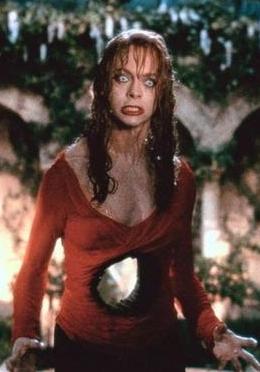Sunday, August 2, 1992.
DEATH BECOMES HER. Written by Martin Donovan and David Koepp. Music by Alan Silvestri. Directed by Robert Zemeckis. Running time: 104 minutes. Mature entertainment with the B.C. Classifier’s warning: some nudity, occasional violence, coarse and suggestive language.
THEY ALL LAUGH WHEN Madeline Ashton (Meryl Streep) falls down the stairs.
There are giggles at the sight of her body, a twisted mess of limbs bent at impossible angles. Here is the corpse promised by the makers of Death Becomes Her.
There are fewer laughs when a shotgun blast hurls Helen Sharp (Goldie Hawn) through the air and into a reflecting pool. Here’s another corpse, this time one with a basketball-sized hole through her middle.
Go ahead and laugh.
Like Madeline’s injuries, Helen’s wound is fatal, not mortal. Like Madeline, she’s up and about within minutes of her death.
Death Becomes Her is director Robert (Back to the Future) Zemeckis’s version of a zombie jamboree. According to screenwriter David Koepp: “We always wondered how Night of the Living Dead would have turned out if Noel Coward had written it.”
Together with partner Martin Donovan, Koepp saw it as the story of two women. Actress Ashton is obsessed with physical appearance and preservation of her fading youth.
Introduced to famous plastic surgeon Ernest Menville (Bruce Willis), the dynamic Maddy quickly steals him away from her "friend," Hel, a mousy book editor. Thereafter, revenge becomes Helen’s life goal.
In the process, both women become disciples of Beverly Hills sorceress Lisle von Rhuman (Isabella Rossellini). She offers them “a touch of magic in this world obsessed by science; a tonic, a potion” that will “stop the aging process dead in its tracks.”
I love these guys. I’ve been in Zemeckis’s corner since 1978, the year I recommended that everybody go out and see his debut feature, I Wanna Hold Your Hand.
I became a Meryl Streep fan when the Oscar-winning actress decided that what she really wanted to do was comedy. In 1989’s She-Devil and Postcards from the Edge (1990), she's shown a real gift for it.
I also like the “bruisable” Bruce Willis (the one we see in the Die Hard movies), and am a willing victim of Isabella Rossellini's classic charm. I wanted to love their current collaboration.
Instead, I only like it.
The problem is the incredible special effects. Between them, the makeup and trick photography crews achieve seemingly impossible feats of visual magic.
As Streep walks across a room with her head on backwards, sheer amazement overwhelms any involvement in the film’s slim story or its essentially superficial characters.
“How do they do that?” I want to know.
Character development, together with Kathleen Turner’s perfect performance, made Zemeckis's Romancing the Stone a great movie. Unfortunately, in the wake of his Who Framed Roger Rabbit triumph, the director insists upon turning all of his actors into ‘toons.
The result, alas, is just good rather than great fun.
The above is a restored version of a Province review by Michael Walsh originally published in 1992. For additional information on this archived material, please visit my FAQ.
Afterword: At first I couldn’t get enough of film school graduate Robert Zemeckis’s comic stylings. Although born with a natural immunity to Beatlemania, I was thorough charmed by his 1978 feature film debut, a hilarious examination of that phenomenon called I Wanna Hold Your Hand. Together with his friend and co-writer Bob Gale, the Chicago-born Zemeckis went on to provide director Steven Spielberg with the screenplay for his wonderfully anarchic (and widely misunderstood) Second World War comedy 1941 (1979). The Zemeckis-Gale collaboration continued with Zemeckis’s second directorial outing, 1980’s Used Cars. A satirical comedy in the style of Mad magazine, it heckled the values championed by then-presidential candidate Ronald Reagan, and died the death at the boxoffice. (It’s since become something of a cult classic.)
in 1984, Zemeckis made his popular breakthrough with the action adventure Romancing the Stone. He sealed the deal a year later, with Back to the Future. Co-written with Gale, the hit time-travel comedy wasn’t supposed to be a series, but the public cried “encore” and Universal Studios responded when their picture became the top-grossing film of the year. They produced two successful sequels — 1989’s Back to the Future Part II and Back to the Future Part III (1990). Zemeckis took the time between Parts I and II to thrill cartooon fans with a treasure chest of classical animation connections, Who Framed Roger Rabbit (1988).
As I said in the above review, I walked into Death Becomes Her prepared to love it. Although I noted his emphasis on the special effects — the picture won the 1993 visual effects Oscar — I didn’t mention the absence of Bob Gale from the screenwriting mix. Although the two remain friends and continue to work together on various projects to this day, Zemeckis has not directed a screenplay co-written with Gale since Back to the Future Part III. In retrospect, I’ve come to believe that life-long comic book fan Gale was the real comedic genius, while Zemeckis provided the high-tech enthusiasm that has become his personal hallmark.
In 1995, Zemeckis won a best director Academy Award for Forrest Gump, a picture I didn’t much like. Actor Tom Hanks, who took home an Oscar for his performance in the title role, has since starred in the Zemeckis features Cast Away (2000) and The Polar Express (2004). Zemeckis has done well with almost all of his subsequent projects, demonstrating his skill with dramas, romantic thrillers, and a survival epic, as well as musical and heroic fantasies. Robert Zemeckis turns 65 today (May 14).
